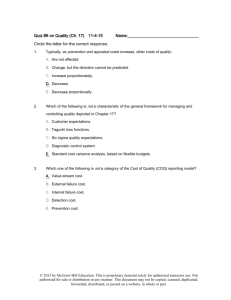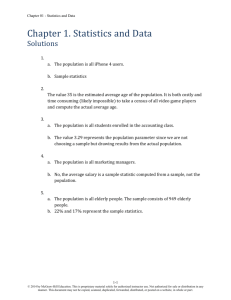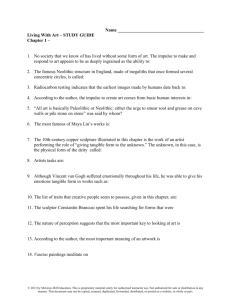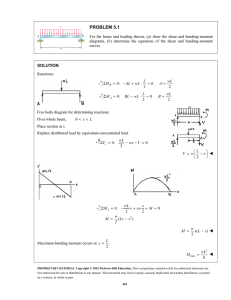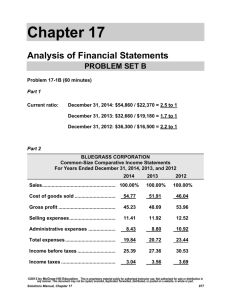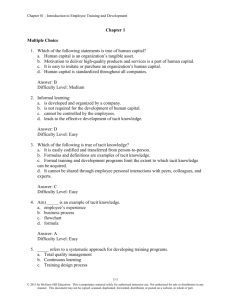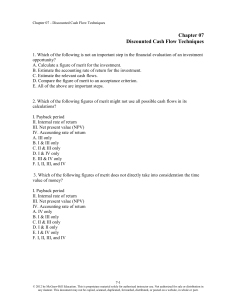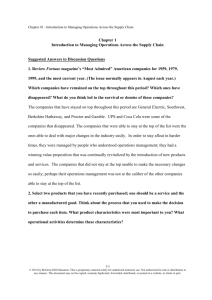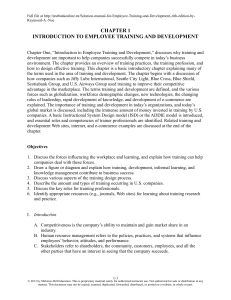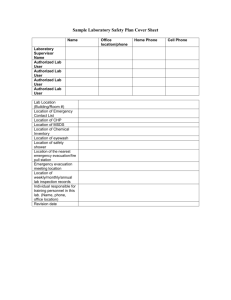Multiple Choice Questions
advertisement
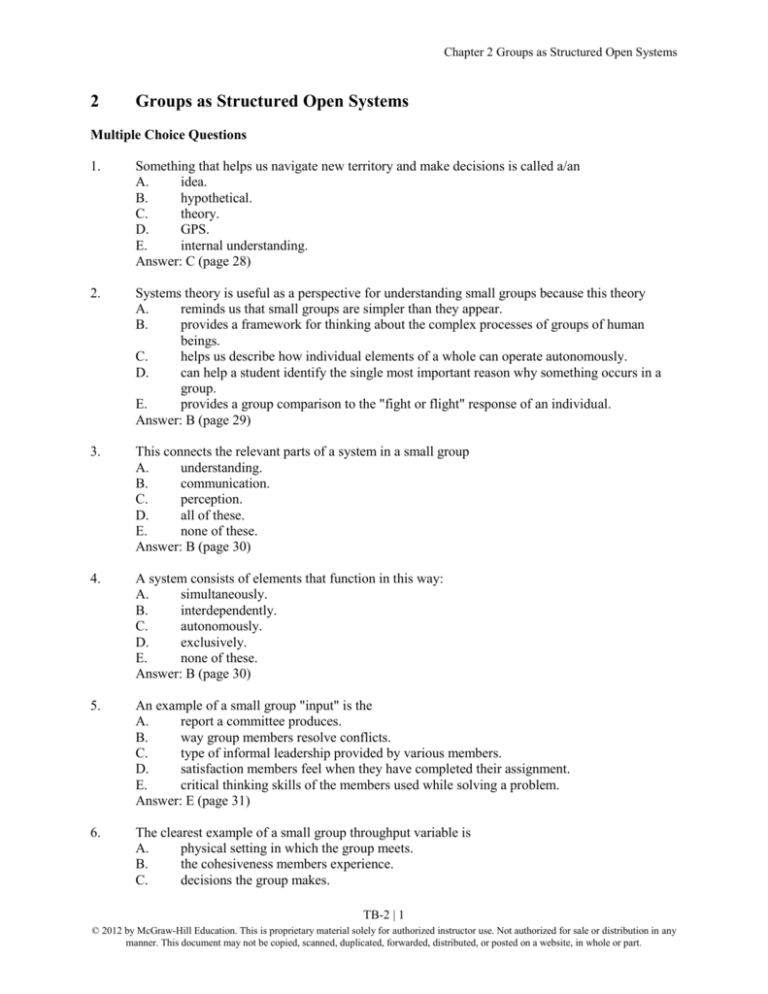
Chapter 2 Groups as Structured Open Systems 2 Groups as Structured Open Systems Multiple Choice Questions 1. Something that helps us navigate new territory and make decisions is called a/an A. idea. B. hypothetical. C. theory. D. GPS. E. internal understanding. Answer: C (page 28) 2. Systems theory is useful as a perspective for understanding small groups because this theory A. reminds us that small groups are simpler than they appear. B. provides a framework for thinking about the complex processes of groups of human beings. C. helps us describe how individual elements of a whole can operate autonomously. D. can help a student identify the single most important reason why something occurs in a group. E. provides a group comparison to the "fight or flight" response of an individual. Answer: B (page 29) 3. This connects the relevant parts of a system in a small group A. understanding. B. communication. C. perception. D. all of these. E. none of these. Answer: B (page 30) 4. A system consists of elements that function in this way: A. simultaneously. B. interdependently. C. autonomously. D. exclusively. E. none of these. Answer: B (page 30) 5. An example of a small group "input" is the A. report a committee produces. B. way group members resolve conflicts. C. type of informal leadership provided by various members. D. satisfaction members feel when they have completed their assignment. E. critical thinking skills of the members used while solving a problem. Answer: E (page 31) 6. The clearest example of a small group throughput variable is A. physical setting in which the group meets. B. the cohesiveness members experience. C. decisions the group makes. TB-2 | 1 © 2012 by McGraw-Hill Education. This is proprietary material solely for authorized instructor use. Not authorized for sale or distribution in any manner. This document may not be copied, scanned, duplicated, forwarded, distributed, or posted on a website, in whole or part. Chapter 2 Groups as Structured Open Systems D. how members express and resolve disagreements. E. information members have about their task. Answer: D (page 32) 7. The scholar who created General Systems Theory was A. Ludwig von Bertalanffy. B. Alfred Einstein. C. Carl Rogers. D. Eric Schlieman. E. John Dewey. Answer: A (page 28) 8. The idea that a group and its environment mutually influence each other is suggested by which perspective? A. idyllic. B. symbolic. C. systemic. D. bona fide group. E. carter’s understanding. Answer: D (page 35) 9. Groups that do not meet face-to-face are called this A. non-seeing. B. fun. C. co-existent. D. interdependent. E. virtual. Answer: E (page 37) 10. "Multiple paths" is used in systems theory to indicate that A. there are numerous ways to improve on a system’s functioning. B. a group can obtain needed inputs from many different sources. C. there is usually more than one appropriate way to reach an objective. D. several members can do a task needed by the group. E. information is exchanged among members via a variety of means and media. Answer: C (page 42) 11. Which of the following is the best example of a closed system? A. a sequestered jury. B. a hockey team. C. an advertising team. D. a person in an interview. E. a learning group. Answer: A (page 38) 12. Which is not an example of a small group output? A. a report produced by the group. B. the satisfaction members experience from a completed job. C. the knowledge and experience of the members. D. a building assembled by a construction crew. E. communication of members with their environment. TB-2 | 2 © 2012 by McGraw-Hill Education. This is proprietary material solely for authorized instructor use. Not authorized for sale or distribution in any manner. This document may not be copied, scanned, duplicated, forwarded, distributed, or posted on a website, in whole or part. Chapter 2 Groups as Structured Open Systems Answer: C (page 34) 13. Which of the following is the most open system? A. a committee which invites non-members to meetings and makes records available to Anyone. B. a club with specific requirements for membership. C. shuttle astronauts on a week-long voyage. D. a jury deliberating about what penalty to give a convict. E. an advertising group debating how to promote a new computer game system. Answer: A (page 38) 14. All of the following are advantages of open systems, except A. access to more information. B. improvement in profits and operation. C. more control over the system. D. none of these. E. all of these. Answer: C (page 39) 15. Which is the best example of an interdependent group goal? A. every member of a study group hoping to get the highest test score. B. a group of sales representatives competing for a bonus. C. completed cars coming off an assembly line. D. four acquaintances playing bridge for a cash prize. E. a basketball team trying to win the state championship. Answer: E (page 39-40) 16. Which is the best example of feedback to a system? A. the members’ knowledge of powerpoint. B. the way the group handles complaints. C. the way the group members address each other. D. customer comment cards. E. none of these. Answer: D (page 41) 17. The best way to give critical feedback is to do which of the following: A. be straight, don’t worry about feelings. B. load up on everything the group did wrong at the beginning of your comments. C. critical feedback should never be given. D. sandwich between positive feedback. E. none of these. Answer: D (page 41). 18. A hockey team’s high morale may be due to the fact that the team has won most of its games, fans cheered lustily, the captain is respected by all players, and the players enjoy being together. Which systems principle does this example illustrate? A. interdependence B. multiple causes C. feedback D. openness E. multiple paths TB-2 | 3 © 2012 by McGraw-Hill Education. This is proprietary material solely for authorized instructor use. Not authorized for sale or distribution in any manner. This document may not be copied, scanned, duplicated, forwarded, distributed, or posted on a website, in whole or part. Chapter 2 Groups as Structured Open Systems Answer: B (page 42) 19. Two college basketball teams are ranked within the Top 5 at the beginning of the season, but by the end of the season team A is ranked within the Top 5 and team B is not even ranked, what system characteristic does this most closely represent? A. multifinality. B. interdependence. C. feedback. D. nonsummativity. E. open system. Answer: A (page 42) 20. Group A consists of the top performing students in the class, while Group B consists of the bottom performing students in the class. At the end of the semester, Group B outdoes Group A on their presentation – what characteristic of the system does this most closely represent? A. equifinality. B. feedback. C. multifinality. D. nonsummativity. E. closed system. Answer: D (page 42) Completion Questions 21. Em Griffin describes _______ as a “map of reality.” Answer: Theory (page 28) 22. A system consists of a set of elements that function ____________ with each other. Answer: Interdependently (page 30) 23. The three broad categories of elements in a small group’s life are called input, __________, and output variables. Answer: Throughput (page 31) 24. _______________are all of the factors that are brought into the group from the outside. Answer: Inputs (page 31) 25. Activities or behaviors of a functioning system are referred to as ____________ processes. Answer: Throughput (page 32) 26. Feelings among members are an example of _______________, an intangible outcome. Answer: Output (page 34) 27. Everything outside a group, which affects the group is referred to as the group’s __________. Answer: Environment (page 34) 28. _____________ emphasizes that groups not only are influenced by their environments but also help shape those same environments. Answer: Bona fide group perspective (page 35) TB-2 | 4 © 2012 by McGraw-Hill Education. This is proprietary material solely for authorized instructor use. Not authorized for sale or distribution in any manner. This document may not be copied, scanned, duplicated, forwarded, distributed, or posted on a website, in whole or part. Chapter 2 Groups as Structured Open Systems 29. Groups in which members complete most or all of their work without meeting are called __________. Answer: Virtual groups (page 37) 30. "Open-closed" refers to the amount of interaction a group has with its _____________. Answer: Environment (page 38) 31. When elements of a system mutually influence each other, they are said to be ______________. Answer: Interdependent (page 39) 32. That part of a group’s output which is recycled as input to help the group stay "on track" is called ___________ . Answer: Feedback (page 41) 33. Having a number of different ways to plan a fun party represents ___________, a characteristic of systems theory. Answer: Multiple Paths (page 42) 34. ______________ means that a group is different from the sum of its components. Answer: Nonsummativity (page 42) 35. Groups experiencing _______________ or negative synergy, were expected to perform well, but did not. Answer: Process loss (page 43) True-False Questions 36. General Systems Theory was created by a theoretical physicist. Answer: F (page 28) 37. Group members’ attitudes toward the project are an example of a small group input variable. Answer: T (page 32) 38. Style of leadership practiced within a group is an example of a small group input variable. Answer: F (page 33) 39. To create an even larger system, a small group must interact with its environment. Answer: T (page 34) 40. A group’s outputs may include changes in its processes and procedures. Answer: T (page 34) 41. Members of groups often belong to other groups, thereby creating more room for mutual influence between the group and the environment. Answer: T (page 35) 42. Describing an organization as a system of small groups is an invalid use of system theory. Answer: F (page 37) 43. Open systems have no disadvantages – it is the most superior system. Answer: F (page 39) TB-2 | 5 © 2012 by McGraw-Hill Education. This is proprietary material solely for authorized instructor use. Not authorized for sale or distribution in any manner. This document may not be copied, scanned, duplicated, forwarded, distributed, or posted on a website, in whole or part. Chapter 2 Groups as Structured Open Systems 44. Within small groups the introduction of a new member can change the functioning of the entire group Answer: T (page 39) 45. Members of the group must rely on each other to achieve their goal. Answer: T (page 40) 46. The source of feedback is not taken into consideration by the group. Answer: F (page 41) 47. The best way to give critical feedback in a group is to not give it. Answer: F (page 41) 48. Multifinality suggests that two successful, experienced sports teams can end up in entirely different spots come playoffs. Answer: T (page 42) 49. Positive synergy accounts for a group of a group of kids who were not picked to play on baseball teams coming together to win the 1998 Little League championship. Answer: T (page 42) 50. An "assembly" effect achieved by a group is equal to the average of the efforts of all members. Answer: F (page 42) Essay or Discussion Questions 51. Explain the many ways in which the systems perspective is useful to the study of small groups. (page 28-30) 52. Use two or more examples to explain how the various elements of a small group are interdependent. Can you think of anything that would affect only one part of a group and not the other parts? (page 30) 53. Give at least three examples each of small group inputs, throughput processes, and outputs. (page 31-34) 54. Explain how technology is changing the way we understand the interaction of group within their environment. (page 37) 55. How is an "open" system different from a "closed" system? List as many ways as you can think of by which a small group might reveal how open or closed it is. (page 38-39) 56. What is "feedback" in a system, and how is it useful to a group? (page 41) 57. Give some examples of feedback that a classroom project group might receive. How should the critical feedback be given to be most useful to the group? (page 41) 58. Explain the idea that outcomes of group effort are the result of multiple causes, multiple paths and nonsummativity. (page 42-43) TB-2 | 6 © 2012 by McGraw-Hill Education. This is proprietary material solely for authorized instructor use. Not authorized for sale or distribution in any manner. This document may not be copied, scanned, duplicated, forwarded, distributed, or posted on a website, in whole or part. Chapter 2 Groups as Structured Open Systems 59. Think of a group you know that developed an outstanding solution to a pressing problem. What are some of the main factors that contributed to the group’s good work? 60. What kinds of subsystems exist within your college or place of employment? How do these groups interact with each other? What, if anything, seems to be missing in such an interaction? How does interaction, or lack of it, seem to affect the organization? TB-2 | 7 © 2012 by McGraw-Hill Education. This is proprietary material solely for authorized instructor use. Not authorized for sale or distribution in any manner. This document may not be copied, scanned, duplicated, forwarded, distributed, or posted on a website, in whole or part.
